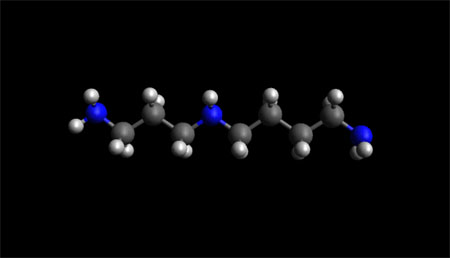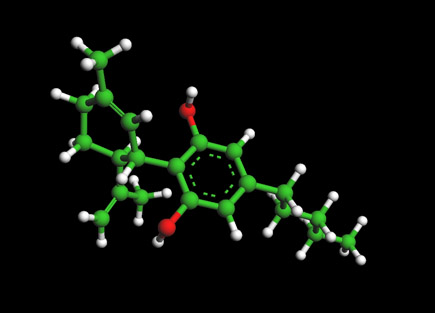Spermidine as a Senolytic and Anti-Aging Molecule

Ball and Stick Model for Spermidine Molecule
Spermidine Molecule (above) Ball-and-stick. For 3D Jsmol File
Molecular formula -- C7H19N3
Molar mass -- 145.250 g·mol−1

Spermidine molecular structure
What is Spermidine?
Spermidine is a polyamine compound (C 7H 19N 3) found in ribosomes and living tissues, and having various metabolic functions within organisms. It was originally isolated from semen.
Spermidine is a longevity agent in mammals due to various mechanisms of action, which are just beginning to be understood. Autophagy is the main mechanism at the molecular level, but evidence has been found for other mechanisms, including inflammation reduction, lipid metabolism, and regulation of cell growth, proliferation and death. see Molecular Basis of the 'Anti-Aging' Effect of Spermidine and Other Natural Polyamines – A Mini-Review
DECLINE OF SPERMIDINE WITH AGE
"...The age-induced spermidine decline must involve the alteration of one or several of the distinct factors that determine systemic availability of spermidine (Figure 1). In principle, spermidine bioavailability is determined by the 3 different sources of this polyamine: (i) cellular biosynthesis, (ii) production by intestinal microorganisms and (iii) nutritional supply, as well as (iv) catabolism and (v) urinary excretion...
...With old age, endogenous spermidine concentrations diminish due to alterations in one or several factors that determine the bioavailability of the substance in the body. This detrimental decline may be counteracted by ingesting polyamine-rich fhttps://www.worldofmolecules.com/molecules-in-the-news/spermidine-rich-foods-may-extend-lifespan.htmlood items, polyamine-enriched plant extracts, synthetic spermidine, or by stimulating polyamine synthesis in the gut microbiome through supplementation of prebiotics or probiotics...." See Figure 1 in: Spermidine: a physiological autophagy inducer acting as an anti-aging vitamin in humans?
See also: Spermidine-rich foods may prevent liver cancer, extend lifespan
26 January 2018 Spermidine in health and disease
"...Having your longevity and eating too Although caloric restriction has clear benefits for maximizing health span and life span, it is sufficiently unpleasant that few humans stick to it. Madeo et al. review evidence that increased intake of the polyamine spermidine appears to reproduce many of the healthful effects of caloric restriction, and they explain its cellular actions, which include enhancement of autophagy and protein deacetylation. Spermidine is found in foods such as wheat germ, soybeans, nuts, and some fruits and vegetables and produced by the microbiota. Increased uptake of spermidine has protective effects against cancer, metabolic disease, heart disease, and neurodegeneration...Although spermidine induces autophagy and autophagy inhibition curtails many of the health-promoting effects of spermidine, additional mechanisms have been proposed to explain the beneficial effects of spermidine on aging. These potentially autophagy-independent mechanisms include direct antioxidant and metabolic effects on arginine bioavailability and nitric oxide (NO) production. .." see full article in Science
Bioavailability and Synthesis in Gut
"...Dietary spermidine is rapidly resorbed from the intestine and distributed in the body without degradation [37]. Thus, food items with high spermidine content can contribute to raising the bioavailability of this polyamine. Such spermidine-rich food items comprise unprocessed plant-derived foods including the durian fruit, shitake mushrooms, fresh green pepper, wheat germ, amaranth grain, cauliflower and broccoli, just to mention a few, but also products resulting from fermentation processes that involve polyamine-generating bacteria and fungi, e.g. soybean products such as natto or many types of mature cheese [38]. Therefore, the systemic levels of spermidine are influenced by diet either directly, by the ingestion of polyamine-rich food items, or indirectly, by effects of the diet on the spermidine-producing microbiota...."
25 February 2019 Polyamines and Gut Microbiota
The microbiota of gut is the community of microbes living in an individual's gastrointestinal tract. Several bacterial genera and species act in a concerted manner to establish metabolic interactions with the host (1). Although there is a general high interest in the study of metabolite flow across the microbe-host, at present, only some studies are targeting specific metabolites produced by intestinal microbiota such as polyamines (PAs) see full publication and references therein
Abstracts:
8 January 2018 Safety and tolerability of spermidine supplementation in mice and older adults with subjective cognitive decline
Supplementation of spermidine, an autophagy-inducing agent, has been shown to protect against neurodegeneration and cognitive decline in aged animal models. The present translational study aimed to determine safety and tolerability of a wheat germ extract containing enhanced spermidine concentrations. In a preclinical toxicity study, supplementation of spermidine using this extract did not result in morbidities or changes in behavior in BALBc/Rj mice during the 28-days repeated-dose tolerance study. Post mortem examination of the mice organs showed no increase in tumorigenic and fibrotic events. In the human cohort (participants with subjective cognitive decline, n=30, 60 to 80 years of age), a 3-month randomized, placebo-controlled, double-blind Phase II trial was conducted with supplementation of the spermidine-rich plant extract (dosage: 1.2 mg/day). No differences were observed between spermidine and placebo-treated groups in vital signs, weight, clinical chemistry and hematological parameters of safety, as well as in self-reported health status at the end of intervention. Compliance rates above 85% indicated excellent tolerability. The data demonstrate that spermidine supplementation using a spermidine-rich plant extract is safe and well-tolerated in mice and older adults. These findings allow for longer-term intervention studies in humans to investigate the impact of spermidine treatment on cognition and brain integrity. see full publication
2018 -- Spermidine delays aging in humans Madeo et.al
Summary: "..External supply of the natural polyamine spermidine can extend life span in model organisms including yeast, nematodes, flies and mice. Recent epidemiological evidence suggests that increased uptake of spermidine with food also reduces overall, cardio- vascular and cancer-related mortality in humans. Here, we discuss the possible mechanisms of this intriguing spermidine effect. Polyamines including spermidine play an essential role in intermediate metabolism. Since they are synthesized by higher eukaryotic cells, they are not vitamins. How- ever, the levels of polyamines are profoundly influenced by their external supply, either by oral ingestion with different food items or by the intestinal microbiota that can synthesize polyamines as well [1]. Our groups have shown over the past decade that supplementing spermidine by adding it to culture media (as we did for the yeast Saccharomyces cerevisiae, the nematode Caenorhabditis elegans and the fruit fly Drosophila melanogaster) or to the drinking water (as we did for the rodent Mus musculus) is sufficient to extend longevity and to improve health span at multiple levels [2, 3]..." see full publications and references herein
14 November 2016 Cardioprotection and lifespan extension by the natural polyamine spermidine
Aging is associated with an increased risk of cardiovascular disease and death. Here we show that oral supplementation of the natural polyamine spermidine extends the lifespan of mice and exerts cardioprotective effects, reducing cardiac hypertrophy and preserving diastolic function in old mice. Spermidine feeding enhanced cardiac autophagy, mitophagy and mitochondrial respiration, and it also improved the mechano-elastical properties of cardiomyocytes in vivo, coinciding with increased titin phosphorylation and suppressed subclinical inflammation. Spermidine feeding failed to provide cardioprotection in mice that lack the autophagy-related protein Atg5 in cardiomyocytes. In Dahl salt-sensitive rats that were fed a high-salt diet, a model for hypertension-induced congestive heart failure, spermidine feeding reduced systemic blood pressure, increased titin phosphorylation and prevented cardiac hypertrophy and a decline in diastolic function, thus delaying the progression to heart failure. In humans, high levels of dietary spermidine, as assessed from food questionnaires, correlated with reduced blood pressure and a lower incidence of cardiovascular disease. Our results suggest a new and feasible strategy for the protection from cardiovascular disease-- see full publication
December 2004 Consumption of Bifidobacterium lactis LKM512 yogurt reduces gut mutagenicity by increasing gut polyamine contents in healthy adult subjects.
The possible role of probiotic metabolites on human health effects of probiotics has received little research attention. In this study, we investigated the effects of consumption of Bifidobacterium lactis LKM512-containing yogurt (LKM512 yogurt) on fecal probiotic metabolites (polyamines, lactate, and acetate) and mutagenicity in seven healthy adults (one male and six females; average age: 30.5 years). Each volunteer was provided with 100g/day of LKM512 yogurt or placebo for 2 weeks. Fecal polyamines and mutagenicity were measured by HPLC and the umu-test, respectively. Consumption of LKM512 yogurt increased fecal spermidine levels, but not fecal lactate and acetate contents. The mutagenicity level significantly reduced to 79.2% (10-91.1%) and 47.9% (0-86.8%) following consumption of LKM512 yogurt (P=0.0293) and placebo (P=0.0314), respectively. LKM512 yogurt consumption significantly reduced the mutagenicity level compared with consumption of a placebo (P=0.0489). These results suggest that increased gut spermidine level by LKM512 yogurt was responsible for the reduction of mutagenicity in the gut of healthy adults. We suggest that spermidine produced by LKM512 yogurt consumption contributes to host health as a bioantimutagenic factor; to our knowledge, these substances have not been previously reported as antimutagens from probiotics or fermented milk. source
Anti-Aging and Senolytics Home Page
- What is Anti-Aging Medicine
- What is Senescence?
- What are Senolytics?
- About Caloric Restriction
- Mtor and Rapamycin
- The IKK/NF-κB signaling pathway in aging
- Exercise and Anti-Aging
- Meditation and Anti-Aging
SENOLYTIC AND ANTI-AGING MOLECULES
RAPAMYCIN ---The mechanistic target of rapamycin (mTOR) pathway has a central role in cell activation...
METFORMIN -- The diabetes drug metformin used by some for anti-aging may diminish benefits of aerobic exercise...
QUERCETIN-- AND WITH DASATINIB--The senolytic cocktail, dasatinib plus quercetin, which causes selective elimination of senescent cells...
FISETIN--Of the 10 flavonoids tested, fisetin was the most potent senolytic...
EGCG- The most active component of green tea....
NAD BOOSTERS --'...The cells of the old mice were indistinguishable from the young mice, after just one week of treatment...
SULFORAPHANE-- An isothiocyanate present in cruciferous vegetables activates antioxidant and anti-inflammatory responses by ...
UROLITHIN --Metabolite of Pomegranate compound with anti-aging effects passes human trial...
MITO-Q -- A water soluble fomr of CoQ10 that has excellent absorption and high bioavailability...
HONOKIOL - A bioactive natural product derived from Magnolia Bark have demonstrated ...
CURCUMIN AND ANALOGS -Recent research is focused on the design and synthesis of curcumin analogs as antiproliferative and anti-inflammatory agents...
BERBERINE --berberine has recently been reported to expand life span in Drosophila melanogaster, and attenuate premature cellular senescence
N-ACETYL-CYSTINE (NAC)--"...pretreatment with NAC increased glutathione levels in the older cells and largely helped offset that level of cell death..."
PIPERLONGUMINE - A natural product from the Long pepper with high bioavailability...
RESVERATROL AND PTEROTSILBINE -- Pterostilben chemically similar to resveratrol bute differs from resveratrol by exhibiting increased bioavailability (80% compared to 20% in resveratrol)
SPERMIDINE--Spermidine delays aging in humans ...
ALLICIN -- Allicin is a compound produced when garlic is crushed or chopped. ...
VITAMIN D3 -- Production of the active forms of Vitamin D are reduced by 50% as a result of an age-related decline
VITAMIN K-- evidence suggests vitamin K has an anti-inflammatory action
TOCOTRIENOL(AND WITH QUERCETIN) --Tocotrieniols have been found to exert a synergistic antitumor effect on cancer cells when given in combination....
HSP-90 INHIBITORS --As a novel class of senolytics
The Cannabidiol Molecule
Cannabidiol (CBD is the major non-psychoactive component of Cannabis and is being looked at by major drug and consumer companies for various medical and social uses.